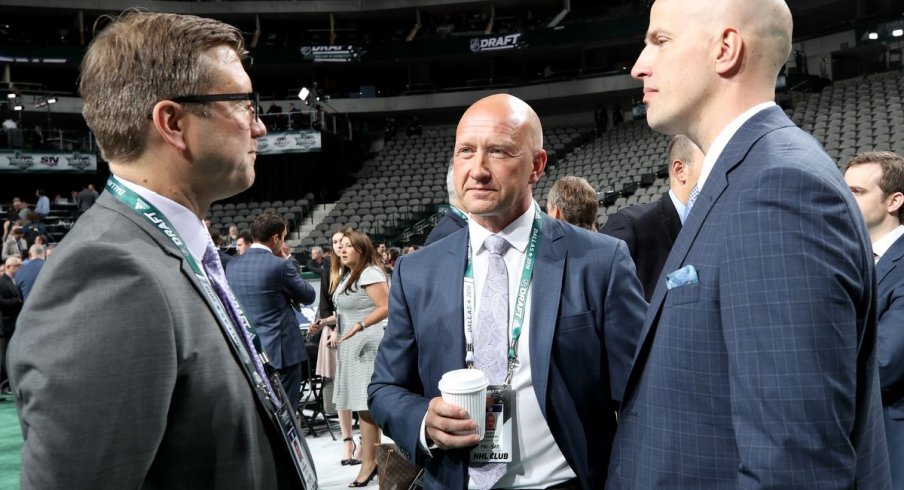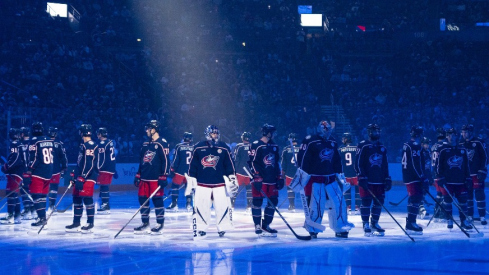With another draft done and in the books, let’s review what the Blue Jackets did.
Not how they did, as there are plenty of sites out there grading teams’ drafts.
What we want to do here is see who they drafted to get further knowledge of how the Blue Jackets draft and if any new trends emerged.
Heading into the draft, I was watching whether the Blue Jackets would pick a prospect from the CHL. As the first round was unfolding. it looked like that trend was going to continue for the Jackets as a couple of the big names still available were European. But the Jackets, as they're known to do, went their own direction and made a splash, picking center Liam Foudy from the OHL's London Knights.
Right away, this confirmed two things: First, the Blue Jackets draft board looks nothing like those that are publicly available (from the pundits). They do their own thing and they trust it. It worked once with the Pierre-Luc Dubois pick, and it remains to be seen if it will work again. Second, this showed the Jackets are willing to go to the CHL for the right player. They don’t appear to actively target the CHL, as Foudy and Trey Fix-Wolansky (WHL) were the only two CHL players they picked, but the total avoidance looks like just a one-off.
We didn’t know at the time, but in retrospect, the Foudy pick was a sign of things to come.
The Jackets put a heavy emphasis on skating this draft. Foudy’s best trait is his elite skating ability and is one of the best skaters in this draft class; Corey Pronman gave his skating a 65 grade on the 20-80 scale, one of just three players from his top 74 to receive a grade that high in skating. Kirill Marchenko isn’t quite to that level but he’s also a very strong skater, especially for someone of his size. Pronman gave him a 55 rating, which is above average.
Pronman isn’t a fan of Marcus Karlberg’s skating but if you read the short scouting report they have on him at EliteProspects, the first word they use is “speedy.” Tim Berni is an average skater and he might be the worst of the group. Trey Fix-Wolansky can be described as a “quick skater...accelerates quickly.”
The Jackets have clearly seen the way the league is headed. It’s much more of a speed-based game now, and teams that have elite speed, like the Vegas Golden Knights, can do some serious damage. The Jackets are clearly getting behind that. This wasn’t just a one year thing; we saw that last season, with Alexandre Texier, Emil Bemstrom, and Jonathan Davidsson, all players considered really good skaters.
This was a semi-new trend for the Jackets, but others stayed the same. The Jackets don’t pick many goalies, but when they do, they tend to be older re-entry players. With their selection of Veini Vehvilainen in the sixth round, the Jackets have now selected four goalies under Jarmo Kekalainen and three of the four have been re-entry players; none have been CHL goalies and none were picked prior to the third round.
This is a sound philosophy to have, as goalies are notoriously volatile year-to-year in the NHL and it’s even worse in junior. By picking re-entry players, you have a larger sample to evaluate from and have a much better idea of who these goalies are. Goalies also take much longer to develop and by taking ones outside of the CHL, the Jackets allow themselves four years to monitor and watch these players grow and mature. With the CHL goalies, you don’t have that luxury and goalies are almost rushed into pro hockey.
The Jackets also continued the trend of not picking more than one defenseman. This is something I suggested before the draft, as the Jackets have struggled at drafting and developing defensemen and it appears they are aware of this. After picking six defensemen in 2015, they have selected just three since – one in each year.
They have also started to shy away from those non-puck moving defensemen that hardly ever work out. Robbie Stucker, who they picked in the seventh round last season, had really good numbers in high school and had a fine season this year in the USHL. Tim Berni, the lone defenseman picked this year, is much more offensive and plays like the typical “new age” defender. He’s skilled, he can move the puck, and can carry the puck for zone entries and exits. He has good hands and likes to shoot, and has the ability to get his shot through traffic and on net.
Overall, this was a sound draft for the Blue Jackets. They had a plan and they stuck to it. They wanted speed and skating and they got that – even if some didn’t agree. They stuck to their strength and picked forwards, and took a shot on an older goalie; now, we just have to wait a few years to see how these players turn out.


